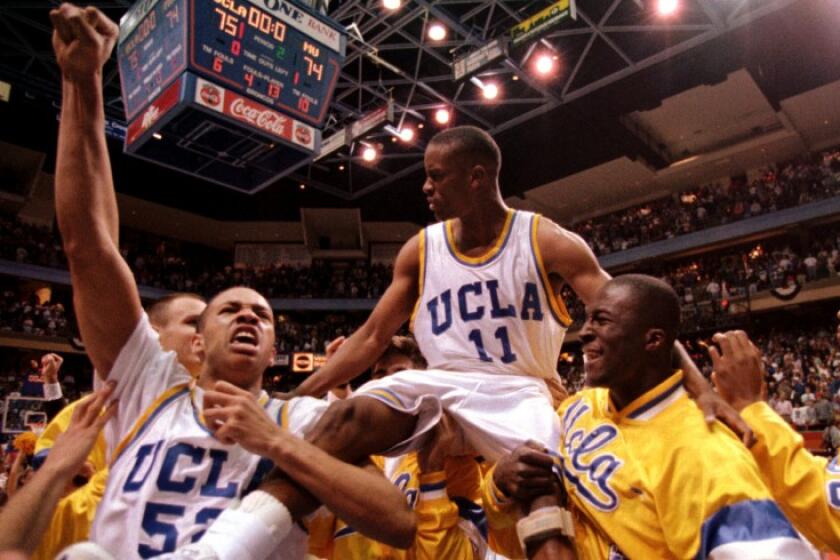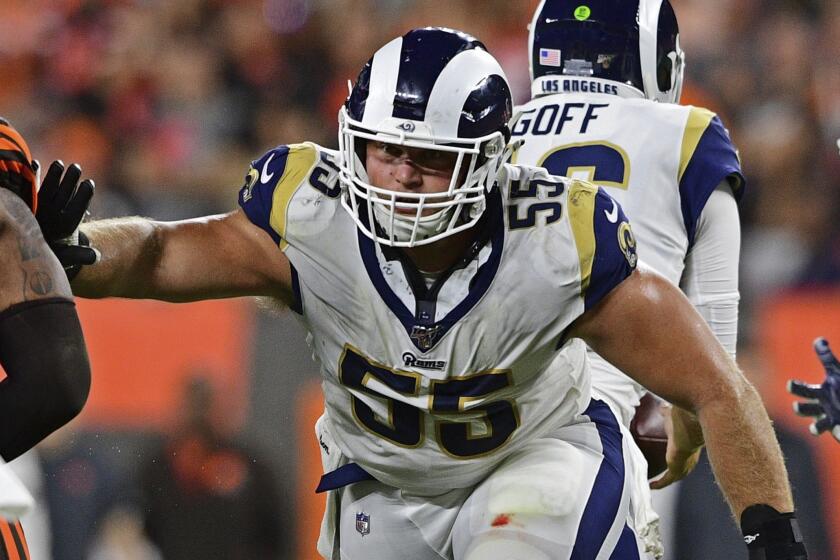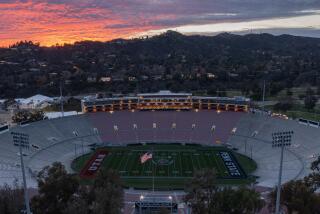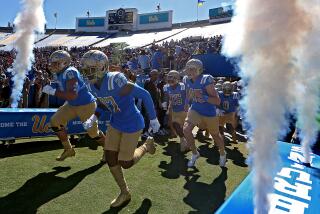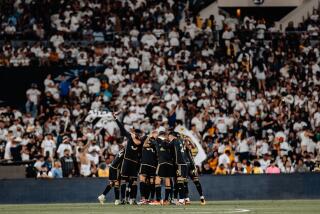Column: A scenic path around the Rose Bowl provides relief from coronavirus crisis

The young couple strolls briskly together around the ancient football stadium in a paved circle of life.
“What do we do?” the man says.
“We walk,” the woman says.
In front of them is a jogger dressed completely in black trash bags.
Behind them is a walker wearing a Brooklyn Dodgers sweatshirt, a Rams ski cap and a mask.
Around them are families riding bikes in a row like ducks, teens jogging through a loud argument, a dude whizzing on roller blades while talking into his phone, and an elderly man earnestly moving forward in dress slacks, a long-sleeve shirt and leather shoes.
On an afternoon when the city around them is shut down because of the threat of the coronavirus, this 3.1-mile path is nonetheless filled with folks searching for a deep breath of faith.
The most iconic shot in UCLA history — by Tyus Edney with 4.8 seconds left in a 1995 March Madness game — originated on a makeshift driveway court.
The Rose Bowl is closed, but it has never felt more open.
The 98-year-old stadium is dark, but it rarely has emanated such light.
The country’s most celebrated football building has hosted 97 Rose Bowls, five Super Bowls, five national championship football games, two soccer World Cup championships and an Olympic championship, and a monthly flea market.
But, perhaps in its most important role yet, it is serving as the centerpiece of brief respite from a virus’ siege. Folks who have nowhere to go come here to travel a perfectly circuitous route around the Rose Bowl and adjoining Brookside Country Club.
The path, which has been used for years, is a dedicated paved lane surrounded by the greenest of Pasadena beauty. On one side are the San Gabriel Mountains. On the other side are the hills of Linda Vista. Smack in the middle is a stadium adorned with the giant rose, a place of great athletic achievements that cannot match the strength of the people who circle it every day, six feet apart but inextricably connected.
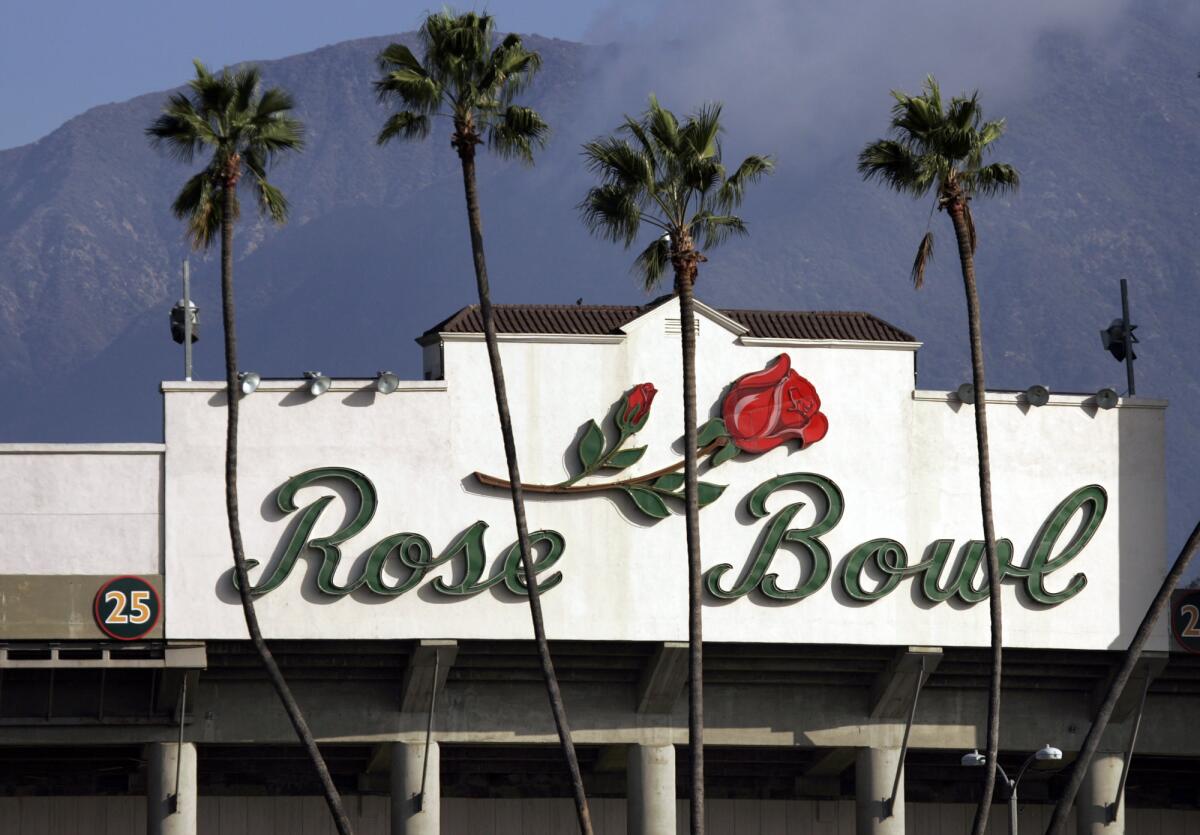
“I’m scared,” the woman says.
They are passed by a streaking runner, two kids on scooters and a mother jogging behind a stroller.
“We’ll be scared together,” the man says.
I think it will be empty. When I show up at the Rose Bowl on Friday afternoon shortly after Pasadena is ordered to shelter in place, I figure the stadium will be standing alone.
I’m somewhat of a Rose Bowl loop regular, I’ve been jogging and walking here for 20 years, and I’ve loved its feeling of community, but I am thinking that community is going to be temporarily wrecked.
I am wrong. I know it the minute I spot the walker wearing a cowboy hat tucked low over a hoodie, being passed by a jogger who had taken off his mask to talk to his running partner. This circular confluence of Rosemont Avenue, West Drive, West Washington Boulevard and Seco Street is filled with dozens of folks embracing a fresh and deep breath.
“Getting outside and walking around here makes you feel like you’re not alone,” says Paige
It’s difficult to accept that residents are better off cooped up like canaries. So they go out, hiking, surfing, surviving amid the coronavirus outbreak.
Dunbar, who teaches a parenting class in nearby La Cañada Flintridge. “I’m not surprised there are a lot of people here because it’s the only place you can be.”
Dunbar is walking with a friend, photographer Stephanie Wiley. They had not seen each other since the pandemic began. They were catching up. That’s what people do here — they circle their lives while circling the Rose Bowl, 3.1 miles of catching up.
“It’s the perfect distance, you can talk about your life in one lap,” Dunbar says.
But on this day, after the two women finished their lap, they walked past their cars parked in Lot K and kept going.
“Today,” Dunbar says, “we needed a little extra.”
Judging from the sweaty smiles of relief on the faces of the Friday afternoon inhabitants of the loop, they all needed a little extra.
“This shows that simple thing of just walking around in a circle can really matter,” says Carl Pierleoni, a Pasadena resident making his second visit of the day. “The Rose Bowl is more than a football stadium. It’s a place for people to come and get away.”
While the Rose Bowl doesn’t formally maintain the loop, it almost always keeps a parking lot open for its inhabitants. A couple of years ago, with money raised by the Rose Bowl Legacy Foundation, it even built an inner miniloop on Rose Bowl property that covers seven-tenths of a mile at the picturesque south end of the stadium.
“It’s refreshing and inspiring, watching this great melting pot of our society,” says Darryl Dunn, longtime Rose Bowl chief executive and general manager.
A look at athletes, coaches and others in the sports world who have tested positive of the coronavirus.
The main loop is only closed during football games or big events, but even then, folks are often seen walking or jogging afterward in the dark.
“There’s always somebody there, always,” Dunn says. “In the rain, in the heat, you look outside and somebody is always there.”
The loop’s popularity happened organically. It is, after all, essentially a natural 5K trip around a national landmark. Legend has it that it became a local institution after high fences were erected around the Brookside course in preparation for the 1968 L.A. Open golf tournament there.
Suddenly, you could walk the loop without fear of getting beaned with a golf ball, although some of Brookside’s patrons are so awful, balls still occasionally escape onto the path. But with the fences came a sense of security, and what has happened since has built a sense of neighborhood togetherness.
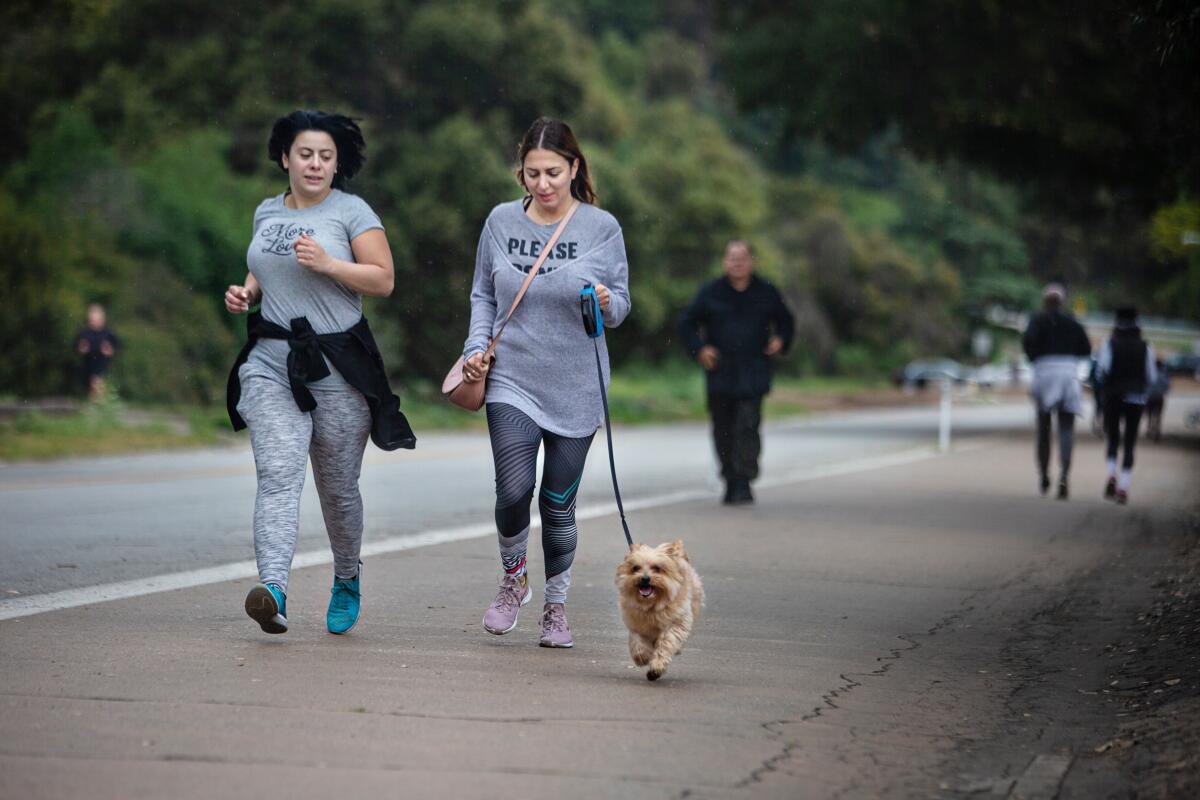
“It’s become its own community,” Dunn says. “People come to the Rose Bowl and feel part of something.”
That bonding has become more important in these days of separation. Memories of the cheers for the last big football game here — Oregon’s Rose Bowl victory over Wisconsin — have been drowned out by the laughter between a mother and her college-age daughter as they swap stories along the loop. The golf course is startlingly empty, but the place has never felt fuller.
Luis Mas, a Caltech scientist, is stretching on his car in Lot K on Friday afternoon when he is asked why he has come to this path in such times of trouble. Is it for the exercise? Is it for the escape?
Before he can answer, three middle-aged men walk past amid great laughter. Behind them a jogging mother is scolding her two teenage boys to slow the heck down.
Above them sits the hulking Rose Bowl, host of the “Granddaddy of Them All,” wearing what one imagines today to be a grandmotherly smile.
“I come here because it’s full of people,” Mas says. “I come here for the life.”
More to Read
Go beyond the scoreboard
Get the latest on L.A.'s teams in the daily Sports Report newsletter.
You may occasionally receive promotional content from the Los Angeles Times.

